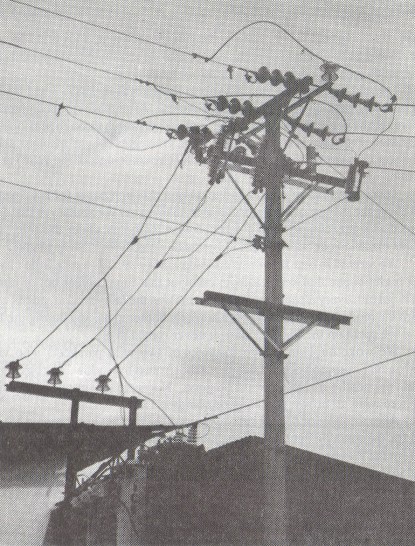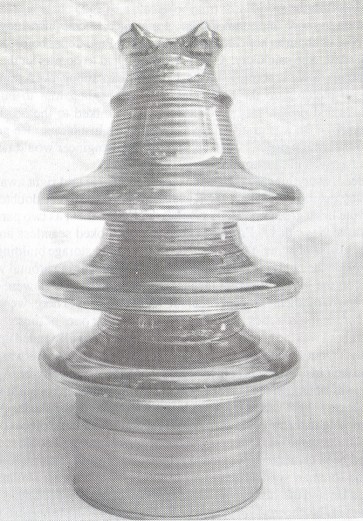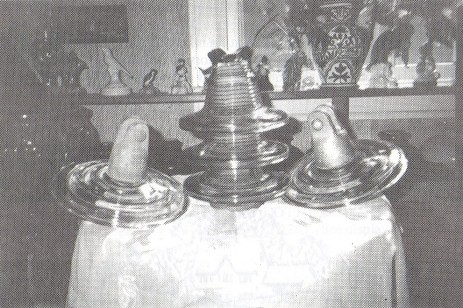Insulator Report: Costa Rica, 1991
by Don Fiene
Reprinted from "Crown Jewels of the Wire", January 1992, page 23
Since 1987 I've been studying Spanish on the side, one course each semester.
By the spring of 1991 I was getting fairly good at it. Judy and I decided that we
should go to Costa Rica at the end of May to test my language skills and see how
much loot we could drag back through customs.
I should mention that my last trip
to Russia was in 1989. I had trouble getting people to sign up in 1990 and had
to cancel. After that I stopped planning trips there. However, I am going to
Russia alone from March through May of 1992 to do research. Probably I can
locate a few large green glass power insulators (like the one show on page 10 of
the November 1989 Crown Jewels of the Wire) in my spare time.
Toward the end of
April I had to write a research paper for my Spanish class. I chose the subject
of insulators so as to sharpen my vocabulary in that area. I produced a lengthy
composition illustrated with 75 photos, under the title, "Los aisladores
electricos devidrio, como objetos de coleccion." I was ready!
We arrived in
San Jose on Wednesday, May 29. It's a nice little city on a rather high plateau
that keeps it from being at that time of year hot or humid though it did rain
every afternoon. Because this was the rainy season, prices were low. But the
modest amount of rain never really bothered us, and during the five hot days we
spent on the Pacific coast, it never rained at all.
We woke on Thursday to
squawks of two wild parakeets who were perched on incoming power lines scarcely a
foot from our window. The birds were great, but the nearby insulators were no
good. Nor were any good in the whole city. There were all brown porcelain or
common U.S.
After a couple of days of driving around the plateau in our rented
car, we headed for the town of Puntarenas, located at the head of a broad bay
reaching north from the Pacific. This city happens to be the western terminus
for the only railroad in the country -- a narrow-gauge line that offers one
round-trip daily, the eastern terminus, 120 miles from Puntarenas, being Limon,
on the Atlantic coast (a site of a recent bad earthquake). In addition to the
one passenger train, the railroad also carries freight. I looked for telegraph
poles along the tracks, but found none in the Puntarenas area. I did, however,
get a lucky look at the passenger train as it came rocking into town with all
the windows wide open. I promised myself to ride that train the next time l hit
Costa Rica, almost certainly in the spring of 1993. After checking out the
miniature train yards and taking pictures, I set out to explore Puntarenas for
insulators. Almost at once I spotted something fantastic: miles of wooden power
poles carrying six high-voltage lines.
There were six large green glass insulators on every pole. (But not a single one on the ground).
They appeared to be of the size and shape of the CD 326 type (Pyrex 453). They
were really striking. I thought they might have been made in France. I was
certain I could get one of these from the power company, but unfortunately, it
was a Sunday. And we had reservations for the next two days for a small hotel
high in the mountains at the edge of a cloud (or rain) forest. We were going to
look for rare birds. And from there we were going to the northwest coast.
Puntarenas should be out of the way, I felt pretty frustrated. Also, we had to leave
right then.

Four large green glass power insulators (very similar in size and
shape to CD
326 Pyrex 453) appear in this photo: One, upper right,
three, lower left. The
letters "ICE" in the transformer are the initials
of the national
Costa Rican electric power company.
The next morning we managed to get a really good long look at a
quetzal bird and his mate in the rain forest. The male is green, red and white,
with a tail three feet long; sometimes the dominant green color of the bird
changes to an iridescent blue right while you are looking at it. There are only
about five hundred of these birds left in the world.
But on to more important things. I managed to convince Judy that it would
only cost us about an hour and a half to swing by Puntarenas before heading
north on Tuesday. She said okay. Good. Now all I had to do was let the power
company know we were coming. This I did by explaining everything very carefully,
with pictures, to the hotel clerk and persuading him to make the necessary calls
and preliminary requests. Finally I talked to the head of the company myself. He
was gratified by my interest in insulators. He gave me directions to their main
office. And he said his chief engineer would take care of me when I arrived in
the morning.
Indeed, everything worked out as planned. I was told right away
that I could have any insulator I wanted. However, the engineer said he doubted
there were any of the large green ones left; he also referred to them as two
part types. I could hardly believe this. From the ground they looked seamless
and new. Finally the engineer assigned a foreman to take me to their storage
buildings. We drove over in our car; Judy ended up doing quite a bit of waiting
around with the temperature in the 90's. We went through six big sheds. There
were tons of insulators -- most of them huge, porcelain and boring. There were many
suspensions or sombrero types. I made a pile of different ones of these. But
all I could think about was the horrible weight. What to do? I finally ended up
taking just two of these, but I wanted them all. In back of one of the sheds was
a huge mound of broken insulators and other debris that had periodically been
burned over. There was not much chance of finding what I wanted there, but it
was the last place to look. There were no green glass power types in the sheds.
After 15 minutes of rooting in the mound I discovered several rather large
pieces of green power type similar to the one I wanted, but about a size
smaller. I could see where two parts had been cemented together. I reluctantly
refrained from keeping the pieces. The foreman verified that the insulators I
craved were similar to the smaller type. He said that after 15 or 20 years all
were long gone from the storage sheds. However, he cheered me up, sort of, by
giving me a unique green glass stacker (in three parts, cemented) that was about
a foot high the weighted maybe 25 pounds. I felt like a real jerk throwing that
into the car, along with the two suspensions and a double handful of interesting
small porcelain pieces for luck. I didn't want to think about how I was going to
get all this stuff into the plane and back home. But basically I was happy.
However, there was a good deal more to this vacation than insulators. There was
also sea shells. I collect them fairly seriously. We spent the next five days on
the Pacific beaches. I personally walked at least fifty miles in that time,
dragging home huge bags of shells and all but drowning in the rivers that
intersected the beaches. I laid out all the shells in our last hotel room,
throwing out half and keeping the rest. By actual count there were a thousand keepers.
A dozen were of good size, three of them "uncommon." (Money in the
bank!) These shells completely filled a sturdy little suitcase, packed in there
by an expert. And heavy, too, by God! I forgot to mention that in all those fifty miles I
walked as a beachcomber, I met no more than a dozen people and none of them were
collecting shells. This was EI Dorado, man.
|

Because the stacker has a long bolt extending from the bottom, I have mounted
it on a cut-down No.1 0 can printed gold. The can fits exactly into one of the
annular grooves on the bottom. I have it sitting on the floor in front of the
fire place. The only mark on this piece is a date written on the base of the
metal pin in black in: 14-12-88. This is probably a prototype of some kind. I
never saw one in use. The glass portion of this insulator is 8" in diameter
at the base and 10-1/2" high. The three separate parts of the stacker are
cemented together. The threaded metal pin in 4-1/4" in diameter at the base
and about 2-1/2" at the top. It is cemented in place. The whole assembly
weighs 24 lbs.
|
Near the end of our second week, we
explored some volcanoes south of San Jose, returning by way of Cartaga, a small
city situated on the one and only railroad. This time I managed to find two
telegraph poles, each with metal cross arms filled with insulators. There were
no wires. On each pole there were maybe two quasi-interesting insulators. The
poles were right in the center of town. One was about a foot away from the side
of a house. The insulators were easily reachable from the roof -- but I would need
a ladder and the permission of the home-owner. I rang the door bell, but no one
answered. It was Sunday, a holiday, people were everywhere. Judy and I walked
back to our car. I wanted to pick up my dictionary and then look for a cop who
might help me grab those insulators. But before I ever got to our vehicle I
spotted a patrol car with two cops in it and waved them over. Hardly had I begun
explaining myself when a second patrol car pulled up. All four cops got out of
their cars and listened to me carefully. I wanted my dictionary bad, but I
managed to tell my story without getting arrested.
|

In addition to the stacker, I brought home two sombreros. One is light ice
blue, almost clear. There is no mark on the glass, but on the metal cape is
written on one side: V GO C/Fidenza/18000 lbs. and the other: 77/10000 lbs.
TEST/1981. The word "Fidenza" (test?) is probably Italian, rather than
Spanish."
The other, medium blue, has only one mark on the glass, near the edge (on the
under side): On the metal cap is written on one side: Mexico...88 [with several
numbers and letters undecipherable]; and on the other side: USA.
|
Actually, the cops seemed to adore me. The five of us all walked together
back along the railroad track to inspect the telegraph pole near the house. This
was an inherently interesting spectacle; numerous onlookers crowded around. I
was sorry to have opened up this particular can of peanuts. But I carried on to
the end. "Get me a ladder," I demanded. But nobody volunteered one.
Then quite unexpectedly the house owner showed up. Even though the cops were
completely on my side, this guy refused to let me up on his roof without
permission from the railway company (or whoever owned the poles). And,
naturally, it was a Sunday, so there was nobody to call. However, the guy did
give me his name and phone number in case I wanted to return the next day and
pursue the matter. I said I would probably not be able to come back. The cops
shook their heads, very sorry about the way things had turned out. Two of them
returned to their car and left. The other two said they had an idea about
getting me some insulators. Judy and I followed them in our car to what turned
out to be the main electrical station for the city. The cops banged on the gate
till the guard appeared. They persuaded him to accommodate me. He took me to a
great heap of broken insulators, among which were four or five that I pretended
I wanted a lot. I thanked everyone profusely. We all smiled and said Adios!
That
was pretty much the end of our vacation -- though I forgot to describe how we found
a tree full of howler monkeys once and spent a good long time admiring them. We
were to depart at 7 a.m. on Tuesday. I spent the whole day Monday building a
crate for the insulators and ingeniously packing and repacking all our stuff so
that we could somehow cope with it. Amazingly, we got through, and did not have
to pay any extra, either. American customs really did not like the crate at all
but decided not to make me open it. When we got back home, we found that not a
single thing had broken -- not one sea shell, not one insulator.
|
